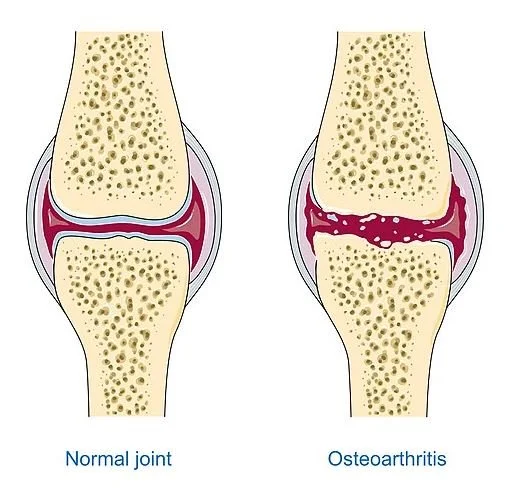Osteoarthritis: Move Better, Feel Better with Exercise
What is Osteoarthritis?
Osteoarthritis (OA) is the most common form of arthritis, affecting millions worldwide. It develops when the cartilage cushioning the ends of bones in joints wears down over time, leading to pain, stiffness, and reduced mobility (Hunter & Bierma-Zeinstra, 2019). OA commonly affects weight-bearing joints like the knees, hips, and spine, but it can also involve smaller joints such as those in the hands.
Why Does It Happen?
OA arises from a combination of factors:
Age: Cartilage naturally weakens with age.
Joint Overuse or Injury: Past injuries or repetitive stress increase OA risk.
Excess Weight: excessive weight can increase your likelihood of developing OA. (Felson, 2013).
Inflammation: Low-grade systemic inflammation may degrade cartilage over time (Mobasheri & Batt, 2016).
Without intervention, OA can worsen, reducing mobility and independence.
Exercise: A Proven Approach to Joint Health
Exercise is one of the most effective ways to preserve joint health and manage OA symptoms. Research highlights the dual benefits of strength training and non-impact cardio in maintaining cartilage health:
Strength Training:
Protects Cartilage: By strengthening the muscles surrounding a joint, strength training reduces mechanical stress on cartilage (Sward et al., 2018).
Promotes Joint Stability: Improved muscular support enhances alignment and reduces abnormal joint loading (Hochberg et al., 2012).
Increases Nutrient Flow: Cartilage relies on movement for nourishment as nutrients are transported through joint fluids during compression and release (Hunter & Bierma-Zeinstra, 2019).
Non-Impact Cardio (e.g., swimming, cycling):
Maintains Cartilage Integrity: Low-impact aerobic exercises stimulate synovial fluid production, which lubricates and nourishes cartilage (Beckwee et al., 2013).
Reduces Inflammation: Aerobic exercise decreases systemic inflammation, which is known to degrade cartilage in OA patients (Mobasheri & Batt, 2016).
Supports Weight Management: Helps prevent excess weight gain, which leads to a multifactorial reduction of risk factors. (Felson, 2013).
Research confirms that combining these exercise types slows OA progression and reduces pain (Goh et al., 2019).
Why Act Now?
Osteoarthritis progresses silently but can be effectively managed with early, consistent exercise. Regular movement not only alleviates stiffness and pain but also actively protects cartilage, improving mobility and quality of life (Hunter & Bierma-Zeinstra, 2019).
Our Concierge Services: Personalized Joint Health Solutions
At Higher Performance Metrics, we offer evidence-based programs tailored to your joint health needs:
Comprehensive assessments to understand your unique joint mechanics.
Personalized exercise plans combining strength, cardio, and flexibility.
Expert guidance to ensure safe and effective movement strategies.
Feel the Difference Today
Take control of your joint health and rediscover the joy of pain-free movement. Let us help you build stronger, healthier joints for life.
Click link to schedule your consultation. Visit our contact page for any questions.
References
Hunter, D. J., & Bierma-Zeinstra, S. (2019). Osteoarthritis. The Lancet, 393(10182), 1745-1759. Link
Felson, D. T. (2013). Osteoarthritis as a disease of mechanics. Osteoarthritis and Cartilage, 21(1), 10-15. Link
Hochberg, M. C., Altman, R. D., April, K. T., Benkhalti, M., Guyatt, G., McGowan, J., ... & Tugwell, P. (2012). Recommendations for the use of nonpharmacologic and pharmacologic therapies in osteoarthritis of the hand, hip, and knee. Arthritis Care & Research, 64(4), 465-474. Link
Mobasheri, A., & Batt, M. (2016). An update on the pathophysiology of osteoarthritis. Annals of Physical and Rehabilitation Medicine, 59(5-6), 333-339. Link
Sward, P., Roos, H., & Struglics, A. (2018). Physical activity and exercise: Their role in preventing cartilage degeneration and osteoarthritis. Sports Medicine, 48(3), 445-467. Link
Goh, S. L., Persson, M. S., Stocks, J., Hou, Y., Lin, J., Hall, M. C., ... & Doherty, M. (2019). Relative efficacy of different types of exercise for treatment of knee and hip osteoarthritis: Network meta-analysis. Annals of the Rheumatic Diseases, 78(5), 660-670. Link
Beckwee, D., Vaes, P., Cnudde, M., Osteaux, M., & Hannu, S. (2013). The impact of physical activity on cartilage health. Osteoarthritis and Cartilage, 21(5), 714-724. Link

